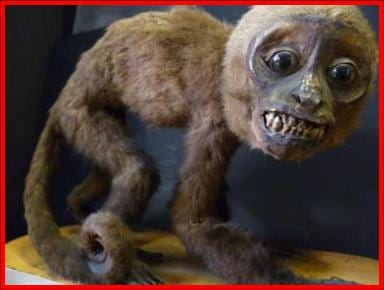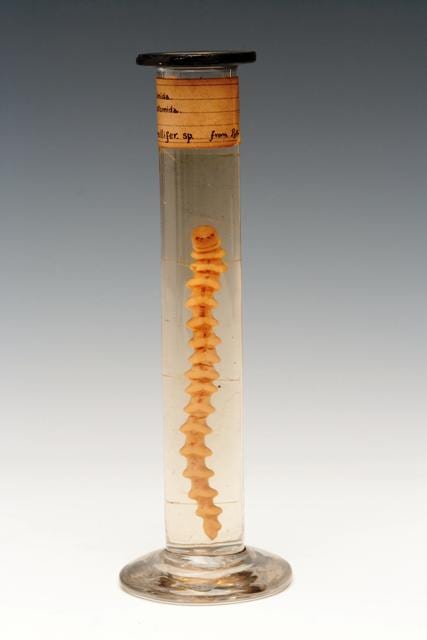Specimen of the Week: Week 144
By Mark Carnall, on 14 July 2014
 Are you settled to read the 144th weekly specimen from the Grant Museum? This week I continue my personal mission to highlight the more obscure, complex and confusing animals. From a very early age our exposure to the animal kingdom is focused on the cute, charismatic and large animals, what we call ‘Hollywood animals‘ here at the Grant Museum. They adorn lunch boxes, T-shirts and fill zoos but the sheer diversity of animal life is so much richer. Why is it that we can all recognise and name specific mammals but lump other huge animal groups under one name- crabs, frogs, spiders etc. Despite the fact that mammal species are but a tiny proportion of all animal species, around 5000 or so out of an estimated 1.5 million described species. It might be that we’re psychologically geared to remembering animals that are like us or perhaps it’s part of our brain wiring to remember animals that can stomp/eat/maul us. Either way, this week’s specimen is one that I’m fairly confident will be new to many of you.
Are you settled to read the 144th weekly specimen from the Grant Museum? This week I continue my personal mission to highlight the more obscure, complex and confusing animals. From a very early age our exposure to the animal kingdom is focused on the cute, charismatic and large animals, what we call ‘Hollywood animals‘ here at the Grant Museum. They adorn lunch boxes, T-shirts and fill zoos but the sheer diversity of animal life is so much richer. Why is it that we can all recognise and name specific mammals but lump other huge animal groups under one name- crabs, frogs, spiders etc. Despite the fact that mammal species are but a tiny proportion of all animal species, around 5000 or so out of an estimated 1.5 million described species. It might be that we’re psychologically geared to remembering animals that are like us or perhaps it’s part of our brain wiring to remember animals that can stomp/eat/maul us. Either way, this week’s specimen is one that I’m fairly confident will be new to many of you.
Prepare to be amazed, this week’s specimen of the week is…
**The Tongue Worm, Armillifer**
1) “Another worm? How many are there?” You may be thinking and yes, we’ve had penis worms and peanut worms in recent weeks. However, despite me just telling you this specimen is a worm it isn’t actually a worm, it’s a crustacean- that group of animals that is best known from crabs, shrimp and lobsters. See, I told you you’d be amazed! You wouldn’t be the first to be confused by this worm that isn’t a worm. These animals have had a chequered history with scientists’ attempts to accurately identify which animals tongue worms are most closely related to. Historically they’ve been tied to millipedes, mites, annelid worms, nematode worms, cestode worm and even water bears (a group of tiny arthropod-like animals; not the furry kind that live near water). Our specimen wears its history on its label, and was labelled when it was thought that these animals were arachnids. Currently tongue worms, making up the Subclass Pentastomida, are thought to be crustacean arthropods due to the structure of their skin, the anatomy and development of their larval stages and the morphology of their sperm.
2) Tongue worms are parasites and like other parasitic animals they have evolved an anatomy suited to the precarious way of life living inside other animals. The body plan of a tongue worm is essentially a mouth with four clawed hooks (the mouth and hooks making five ‘appendages’ hence the pent bit of their group name), a gut and the equipment for reproduction. They are perfectly evolved to focus exclusively on the business of feeding and breeding. Tongue worms don’t have circulatory, respiratory, or excretory organs instead getting all they need from the blood of their host animals. It is because they have evolved such a degenerate anatomy that working out the affinities of this group has been so problematic.

Close up of the head region of LDUCZ-J143. The four brown spikes are the hooks (called hamuli) the mouth is between the middle two.
3) Pentastomids’ favourite place to hang out is the respiratory system of reptiles, birds, fish, amphibians and mammals. This specimen is recorded as coming from a python and tongue worm infestations are a common problem for snakes kept in captivity. The eggs that they lay are either coughed up or passed through the digestive system of the host. If they are lucky, the eggs are then ingested by an intermediate host animal where the larvae hatch, tear out of the intestine and form a cyst. The larvae then develop into the adult worm form and they wait until their host is eaten by another animal where they then find their way to the respiratory system of their final host and start again, if they aren’t chewed in the process. Given that there’s a high risk of death or ending up inside the wrong kind of animal at every step, as far as life cycles go it puts our slightly embarrassing ordeal at adolescence to shame.
4) Tongue worms can infect humans directly and indirectly. There’s a host (ha ha) of medical terms for tongue worm infestations. Generally, an infestation of tongue worms is called pentastomiasis; the specific disease caused by Armillifer worms is called porocephalosis. Porocephalosis is particularly grim because Armillifer larvae finding themselves in the wrong intermediate host (humans) burrow into tissue whereupon they subsequently die and stimulate a response which sometimes results in calcification of the cyst. These calcified dead tongue worm larvae in your flesh can be seen in X-rays and if you end up with a lot of them they can cause death. Lovely stuff.
5) The evolution of this group is particularly enigmatic. Today, adult tongue worms exclusively parasitize vertebrates with some using invertebrates as intermediate hosts as larvae, however, surprisingly fossils of pentastomids are found in rocks as old as 500 million years and are readily recognised as tongue worms, complete with the degenerated morphology we see in today’s species. This begs the questions; what did pentastomids evolve from, what were they parasitising in a world before vertebrates (at the time our ancestors were about 2cm long) and how did they make the jump to vertebrates?
So there we have it, aren’t tongue worms just the best? Do tongue worms a favour and tell a friend about them perhaps at a dinner party setting or during an awkward silence. They could do with the PR.
Mark Carnall is the Curator of the Grant Museum of Zoology
4 Responses to “Specimen of the Week: Week 144”
- 1
-
2
Lorna Steel wrote on 23 July 2014:
Interesting. Do these animals cause the disease called ‘lungworm’ in dogs?
 Close
Close



I just had a quick question. I’m headed into college and looking towards a degree in zoology or ecology. I love animals and everything about them. I want to work with them but not as a veterinarian so I think zoology is for me, but it’s not a large field and seems hard to get into, especially the field work. I just don’t want to mess up and need some feedback or your input on what you do and what it’s like. Thank you so much.